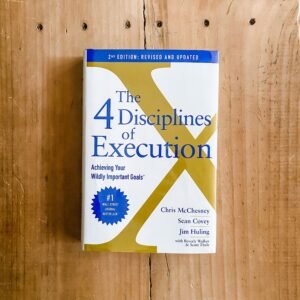Hey there, fellow productivity enthusiasts and procrastination champions! Ever feel like you’re trapped in a never-ending cycle of setting goals, getting excited, and then watching them slowly fade away into the abyss of forgotten New Year’s resolutions? Well, buckle up, buttercup, because we’re about to dive into the world of “The 4 Disciplines of Execution” (4DX) by Chris McChesney, Sean Covey, and Jim Huling. This book might just be the superhero cape you need to finally conquer your goals and emerge victorious over the villainous “whirlwind” of daily life.
The Whirlwind: Your Arch-Nemesis

Picture this: You’re sitting at your desk, armed with a shiny new planner and a heart full of ambition. You’ve got big plans, my friend. You’re going to revolutionize your business, learn three languages, and finally organize that junk drawer that’s been mocking you for years. But then… the whirlwind strikes!
What’s the whirlwind, you ask? It’s that pesky tornado of everyday tasks that swoops in and scatters your grand plans to the four winds. It’s the emails, the meetings, the “quick favors,” and that one coworker who always needs “just five minutes” (spoiler alert: it’s never just five minutes). The whirlwind is why most of us end up feeling like hamsters on a wheel, running frantically but never actually getting anywhere. It’s the reason why, come December, we’re left wondering where the year went and why we still can’t speak Mandarin. But fear not, dear reader! The 4DX framework is here to help you break free from the whirlwind’s clutches and actually achieve your wildly important goals (WIGs). Let’s break it down, shall we?
Discipline 1: Focus on the Wildly Important (Or, How to Stop Being a Goal Hoarder)
First things first: we need to talk about your goal hoarding problem. Yes, you. I see you there with your list of 37 “top priorities.” It’s time for an intervention.
The first discipline of 4DX is all about focus. Instead of trying to juggle a gazillion goals, you need to channel your inner Marie Kondo and declutter that goal list. Pick one (or at most two) wildly important goals. These are your WIGs, and they should be so important that failing to achieve them would make all your other achievements feel like participation trophies.
Here’s the kicker: your WIG should be simple, vital, and specific. None of this “I want to be better” nonsense. We’re talking “increase revenue from $X to $Y by December 31st” or “reduce customer complaints by 50% in the next quarter.” Make it measurable, make it time-bound, and for the love of all that is productive, make it wildly important!
Discipline 2: Act on the Lead Measures (Or, How to Stop Obsessing Over the Scale)
Alright, you’ve got your WIG. Now, here’s where most people go wrong: they focus solely on the end result. It’s like obsessively weighing yourself every day when you’re trying to get fit. Sure, the number on the scale (or your revenue, or your customer satisfaction score) is important, but it’s a lag measure. It tells you what has already happened. Enter lead measures: the secret sauce of 4DX. These are the activities that drive your WIG. They’re like the daily workouts and healthy meals that lead to weight loss. The beauty of lead measures is that you have direct control over them. For example, if your WIG is to increase sales, your lead measures might be “make 20 cold calls per day” or “conduct 5 product demos per week.” These are actions you can take right now that will influence your WIG. So, stop staring at that lag measure like it’s going to magically change. Focus on crushing those lead measures, and watch as they pull your WIG along for the ride!
Discipline 3: Keep a Compelling Scoreboard (Or, How to Make Work Feel Like a Video Game)

Let’s face it: spreadsheets are about as exciting as watching paint dry. But what if I told you that keeping score could actually be… fun?
The third discipline is all about creating a scoreboard that’s so compelling, your team will be fighting over who gets to update it. This isn’t your grandpa’s dusty old leaderboard. We’re talking a dynamic, visual representation of your progress that even the most spreadsheet-phobic team member can understand at a glance. Your scoreboard should show both lead and lag measures, making it crystal clear whether you’re winning or losing. And trust me, once people can see the score, they’ll naturally want to win. It’s human nature. We’re all just big kids who want to see our names at the top of the leaderboard.
So, channel your inner game designer and create a scoreboard that’s part infographic, part motivational poster, and 100% impossible to ignore. Bonus points if you can incorporate sound effects or flashing lights when you hit milestones!
Discipline 4: Create a Cadence of Accountability (Or, How to Make Meetings Not Suck)

Ah, meetings. The bane of modern work life. But what if I told you that there’s a way to have meetings that are actually productive, engaging, and dare I say it… enjoyable? Enter the WIG session: a weekly meeting so sacred, it makes Fight Club look like a casual get-together. This isn’t your average “status update” snoozefest. Oh no, this is where the magic happens.
Here are the rules of WIG Club:
- You do talk about WIG Club. In fact, you talk about it every single week, at the same time, without fail.
- The whirlwind is not invited. No matter how much it begs, cries, or threatens to burn down the office, it stays outside.
- Every team member makes specific, personal commitments to move the lead measures.
- You review last week’s commitments, check the scoreboard, and make new commitments for the coming week.
These meetings are fast-paced, focused, and actually get stuff done. It’s like productivity parkour for your brain.
The Secret Sauce: Personal Accountability
Here’s where 4DX really shines: it’s all about personal accountability. Each team member makes their own commitments. No more hiding in the back of the room, hoping the boss won’t call on you. Everyone’s in the game, everyone’s on the scoreboard, and everyone’s responsible for moving those lead measures. It’s like the workplace equivalent of “put your money where your mouth is.” Except instead of money, it’s your pride, your reputation, and your burning desire to see your name at the top of that scoreboard.
Implementing 4DX: It’s Not a Sprint, It’s a… Actually, It Kind of Is a Sprint
Now, I know what you’re thinking. “This sounds great, but how do I actually implement this in my chaotic, whirlwind-infested workplace?”
Well, my friend, implementing 4DX is a bit like trying to change the tires on a moving car. It’s tricky, it’s a bit scary, and there’s a good chance someone’s going to get a face full of grease. But with patience, persistence, and a healthy dose of humor, it can be done. Start small. Pick one team, one WIG, and go all in. Embrace the inevitable awkwardness of your first few WIG sessions. Laugh at the hilariously bad first attempts at creating a scoreboard. Celebrate the small wins, learn from the failures, and keep pushing forward. Remember, 4DX isn’t about perfection. It’s about progress. It’s about slowly but surely taming that whirlwind and carving out space for what truly matters.
The 4DX Mindset: Beyond the Boardroom
Here’s a little secret: 4DX isn’t just for business. These principles can revolutionize your personal life too. Want to write that novel? Learn to play the ukulele? Finally beat your kid at Mario Kart? The 4DX framework can help.Imagine a world where you have a compelling scoreboard for your fitness goals on the fridge, where your family has weekly WIG sessions to plan the most epic vacation ever, or where you and your friends compete to see who can save the most money for that group trip to Vegas. The possibilities are endless, and dare I say, wildly important.
Conclusion: Embrace the 4DX Revolution
So there you have it, folks. “The 4 Disciplines of Execution” isn’t just another business book destined to gather dust on your shelf. It’s a battle cry for anyone who’s ever felt overwhelmed, unfocused, or just plain stuck. It’s permission to stop trying to do everything and focus on what really matters. It’s a framework for turning vague aspirations into concrete actions. It’s a way to make progress visible, celebration inevitable, and success achievable. So, are you ready to tame your whirlwind? Are you prepared to focus on the wildly important, act on lead measures, keep a compelling scoreboard, and create a cadence of accountability? Are you willing to transform your workplace, your goals, and maybe even your life? The choice is yours. But remember, as the great philosopher Yoda once said, “Do or do not. There is no try.” (Okay, Yoda probably wasn’t talking about 4DX, but you get the idea.)
Now go forth, conquer your WIGs, and may the four disciplines be with you!
Want to level up with this book, check it out here: The 4 Disciplines of Execution: Revised and Updated: Achieving Your Wildly Important Goals

